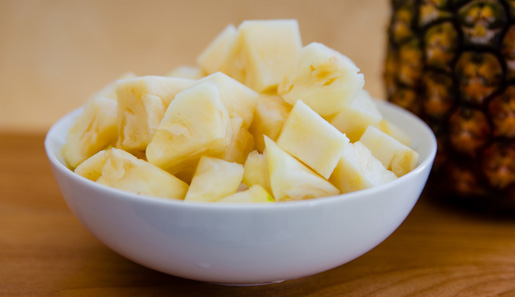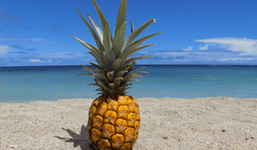 |
|
SPOTLIGHT |
|
|
|
|
|
| Hawaii’s Honey Cream |
There’s a new pineapple in Hawaii, and it’s creating quite a stir in our stores! Called the Meli Kalima or “Honey Cream,” this patented fruit was developed by Frank Sekiya, owner of Frankie’s Nursery in Waimanalo. Meli refers to the fruit’s rich sweetness, while kalima describes the light yellow flesh color and creamy texture. Round in shape with an average size of 3 pounds, this unique fruit with crisp texture is truly something to taste and behold.
Here’s more you might like to know about these delicious, sweet, creamy summer treats:
|
Cream of the Crop: The Honey Cream is a cross between the “Dry Sweet” and “Hilo White” pineapple varieties. Frankie planted all the seeds from the original hybrid plant and came up with about 50 selections he thought were good. As it turns out, lucky number 13 produced the sweetest and best fruit, and Frankie’s Nursery began growing and marketing it as the Meli Kalima.
Where’s the Top?: Frankie’s Nursery sells the Honey Cream with the crown removed in an effort to protect its patent. Since pineapples can be regrown from their spiky, leafy tops, removing these crowns is one important way to prevent unauthorized propagation.
Don’t Let the Color Fool You: Frankie’s only picks its pineapples at the peak of perfection. So while the outer skin of the Honey Cream may still be green, rest assured that the pale, creamy fruit underneath is as sweet as can be. Honey Creams are not only sweet throughout the year, but they are lower in acid and less fibrous than other pineapples.

All About The Brix: Farmers and wine makers measure sweetness in a measure called Brix. The higher the Brix, the sweeter the food. The average pineapple comes in around 14 on the Brix scale; apples, bananas, peaches and strawberries average a score of 10; honey has a Brix count of 32, and a score of 20 is considered very good. That Frankie’s Meli Kalima has a Brix score of 28 — and only drops to 21 for a few months in the winter — is a clear indication of just how sweet it is!
Good For You Too: Considered a sweet treat that’s good to eat, pineapple is also known for its many health benefits. Not only do pineapples have the ability to improve respiratory health, digestion, oral health, eye health, heart health, and the immune system, but they can also help you lose weight, strengthen bones, reduce inflammation, prevent cancer, fight off infections and parasites, and increase circulation. So eat up and feel good about it!
|
|
|
|
| Did You Know? |
 |
 |
|
| Although Captain John Kidwell is credited as being the founder of Hawaii’s pineapple industry and James Dole is referred to as the “Pineapple King” for pioneering the industry in the islands, neither man was actually responsible for bringing the first pineapple to Hawaii. That credit goes to Don Francisco de Paula y Marin, a trusted advisor of King Kamehameha I who is said to have introduced the fruit to the islands in 1813. |
|
|
|
|
 |
|
RECIPES |
|
|
|
|
|
| Pina Colada Popsicles |
| Makes 10 Popsicles |
|
|
|
| A cool treat, perfect for summer days! Creamy and sweet, with a touch of coconut, these refreshing popsicles are so easy to make, you won’t even break a sweat! |
| INGREDIENTS |
- 2 cups reduced fat coconut milk
- 1 small Honey Cream pineapple, cored and chopped
- 7 tablespoons agave syrup
- 1 lime, zested and juiced
- ¼ cup coconut flakes
|
| Special Equipment |
- Popsicle molds
- Popsicle sticks
|
| INSTRUCTIONS |
- Combine coconut milk, pineapple, agave and lime juice together in a blender and process until smooth.
- Pour the mixture into popsicle molds. Carefully insert a popsicle stick into each mold.
- Freeze overnight or until solid.
- Before serving, allow to sit at room temperature for about a minute. Sprinkle on all sides with coconut flakes and lime zest.
|
| Adult Variation: Add ½ cup of rum to the mixture before pouring into molds. |
|
 |
| Did you make this recipe? |
| Let us know how it turned out for you! Share a picture on Instagram with the hashtag #FoodlandEatLocal |
|
| How can you tell it’s local? |
| Look for the ORANGE SIGNS |
| to find locally grown and locally made items throughout our stores. |
|
|
|
|
|
|
|

